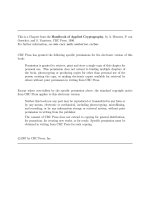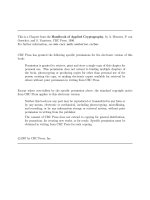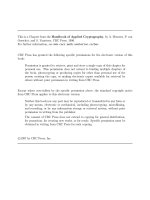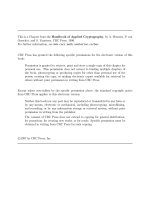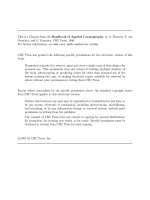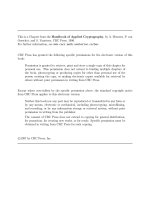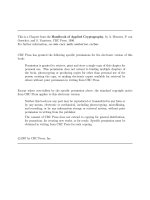applied cryptography 2nd ed. - b. schneier
Bạn đang xem bản rút gọn của tài liệu. Xem và tải ngay bản đầy đủ của tài liệu tại đây (8.44 MB, 1,027 trang )
Brief Full
Advanced
Search
Search Tips
To access the contents, click the chapter and section titles.
Applied Cryptography, Second Edition: Protocols, Algorthms, and Source
Code in C (cloth)
(Publisher: John Wiley & Sons, Inc.)
Author(s): Bruce Schneier
ISBN: 0471128457
Publication Date: 01/01/96
Search this book:
Foreword by Whitfield Diffie
Preface
About the Author
Chapter 1—Foundations
1.1 Terminology
1.2 Steganography
1.3 Substitution Ciphers and Transposition Ciphers
1.4 Simple XOR
1.5 One-Time Pads
1.6 Computer Algorithms
1.7 Large Numbers
Part I—Cryptographic Protocols
Chapter 2—Protocol Building Blocks
2.1 Introduction to Protocols
2.2 Communications Using Symmetric Cryptography
2.3 One-Way Functions
2.4 One-Way Hash Functions
2.5 Communications Using Public-Key Cryptography
2.6 Digital Signatures
Go!
Keyword
Go!
2.7 Digital Signatures with Encryption
2.8 Random and Pseudo-Random-Sequence Generation
Chapter 3—Basic Protocols
3.1 Key Exchange
3.2 Authentication
3.3 Authentication and Key Exchange
3.4 Formal Analysis of Authentication and
Key-Exchange Protocols
3.5 Multiple-Key Public-Key Cryptography
3.6 Secret Splitting
3.7 Secret Sharing
3.8 Cryptographic Protection of Databases
Chapter 4—Intermediate Protocols
4.1 Timestamping Services
4.2 Subliminal Channel
4.3 Undeniable Digital Signatures
4.4 Designated Confirmer Signatures
4.5 Proxy Signatures
4.6 Group Signatures
4.7 Fail-Stop Digital Signatures
4.8 Computing with Encrypted Data
4.9 Bit Commitment
4.10 Fair Coin Flips
4.11 Mental Poker
4.12 One-Way Accumulators
4.13 All-or-Nothing Disclosure of Secrets
4.14 Key Escrow
Chapter 5—Advanced Protocols
5.1 Zero-Knowledge Proofs
5.2 Zero-Knowledge Proofs of Identity
5.3 Blind Signatures
5.4 Identity-Based Public-Key Cryptography
5.5 Oblivious Transfer
5.6 Oblivious Signatures
5.7 Simultaneous Contract Signing
5.8 Digital Certified Mail
5.9 Simultaneous Exchange of Secrets
Chapter 6—Esoteric Protocols
6.1 Secure Elections
6.2 Secure Multiparty Computation
6.3 Anonymous Message Broadcast
6.4 Digital Cash
Part II—Cryptographic Techniques
Chapter 7—Key Length
7.1 Symmetric Key Length
7.2 Public-Key Key Length
7.3 Comparing Symmetric and Public-Key Key Length
7.4 Birthday Attacks against One-Way Hash Functions
7.5 How Long Should a Key Be?
7.6 Caveat Emptor
Chapter 8—Key Management
8.1 Generating Keys
8.2 Nonlinear Keyspaces
8.3 Transferring Keys
8.4 Verifying Keys
8.5 Using Keys
8.6 Updating Keys
8.7 Storing Keys
8.8 Backup Keys
8.9 Compromised Keys
8.10 Lifetime of Keys
8.11 Destroying Keys
8.12 Public-Key Key Management
Chapter 9—Algorithm Types and Modes
9.1 Electronic Codebook Mode
9.2 Block Replay
9.3 Cipher Block Chaining Mode
9.4 Stream Ciphers
9.5 Self-Synchronizing Stream Ciphers
9.6 Cipher-Feedback Mode
9.7 Synchronous Stream Ciphers
9.8 Output-Feedback Mode
9.9 Counter Mode
9.10 Other Block-Cipher Modes
9.11 Choosing a Cipher Mode
9.12 Interleaving
9.13 Block Ciphers versus Stream Ciphers
Chapter 10—Using Algorithms
10.1 Choosing an Algorithm
10.2 Public-Key Cryptography versus Symmetric
Cryptography
10.3 Encrypting Communications Channels
10.4 Encrypting Data for Storage
10.5 Hardware Encryption versus Software Encryption
10.6 Compression, Encoding, and Encryption
10.7 Detecting Encryption
10.8 Hiding Ciphertext in Ciphertext
10.9 Destroying Information
Part III—Cryptographic Algorithms
Chapter 11—Mathematical Background
11.1 Information Theory
11.2 Complexity Theory
11.3 Number Theory
11.4 Factoring
11.5 Prime Number Generation
11.6 Discrete Logarithms in a Finite Field
Chapter 12—Data Encryption Standard (DES)
12.1 Background
12.2 Description of DES
12.3 Security of DES
12.4 Differential and Linear Cryptanalysis
12.5 The Real Design Criteria
12.6 DES Variants
12.7 How Secure Is DES Today?
Chapter 13—Other Block Ciphers
13.1 Lucifer
13.2 Madryga
13.3 NewDES
13.4 FEAL
13.5 REDOC
13.6 LOKI
13.7 Khufu and Khafre
13.8 RC2
13.9 IDEA
13.10 MMB
13.11 CA-1.1
13.12 Skipjack
Chapter 14—Still Other Block Ciphers
14.1 GOST
14.2 CAST
14.3 Blowfish
14.4 SAFER
14.5 3-Way
14.6 Crab
14.7 SXAL8/MBAL
14.8 RC5
14.9 Other Block Algorithms
14.10 Theory of Block Cipher Design
14.11 Using one-Way Hash Functions
14.12 Choosing a Block Algorithm
Chapter 15—Combining Block Ciphers
15.1 Double Encryption
15.2 Triple Encryption
15.3 Doubling the Block Length
15.4 Other Multiple Encryption Schemes
15.5 CDMF Key Shortening
15.6 Whitening
15.7 Cascading Multiple Block Algorithms
15.8 Combining Multiple Block Algorithms
Chapter 16—Pseudo-Random-Sequence
Generators and Stream Ciphers
16.1 Linear Congruential Generators
16.2 Linear Feedback Shift Registers
16.3 Design and Analysis of Stream Ciphers
16.4 Stream Ciphers Using LFSRs
16.5 A5
16.6 Hughes XPD/KPD
16.7 Nanoteq
16.8 Rambutan
16.9 Additive Generators
16.10 Gifford
16.11 Algorithm M
16.12 PKZIP
Chapter 17—Other Stream Ciphers and Real
Random-Sequence Generators
17.1 RC4
17.2 SEAL
17.3 WAKE
17.4 Feedback with Carry Shift Registers
17.5 Stream Ciphers Using FCSRs
17.6 Nonlinear-Feedback Shift Registers
17.7 Other Stream Ciphers
17.8 System-Theoretic Approach to Stream-Cipher
Design
17.9 Complexity-Theoretic Approach to Stream-Cipher
Design
17.10 Other Approaches to Stream-Cipher Design
17.11 Cascading Multiple Stream Ciphers
17.12 Choosing a Stream Cipher
17.13 Generating Multiple Streams from a Single
Pseudo-Random-Sequence Generator
17.14 Real Random-Sequence Generators
Chapter 18—One-Way Hash Functions
18.1 Background
18.2 Snefru
18.3 N- Hash
18.4 MD4
18.5 MD5
18.6 MD2
18.7 Secure Hash Algorithm (SHA)
18.8 RIPE-MD
18.9 HAVAL
18.10 Other One-Way Hash Functions
18.11 One-Way Hash Functions Using Symmetric Block
Algorithms
18.12 Using Public-Key Algorithms
18.13 Choosing a One-Way Hash Function
18.14 Message Authentication Codes
Chapter 19—Public-Key Algorithms
19.1 Background
19.2 Knapsack Algorithms
19.3 RSA
19.4 Pohlig-Hellman
19.5 Rabin
19.6 ElGamal
19.7 McEliece
19.8 Elliptic Curve Cryptosystems
19.9 LUC
19.10 Finite Automaton Public-Key Cryptosystems
Chapter 20—Public-Key Digital Signature
Algorithms
20.1 Digital Signature Algorithm (DSA)
20.2 DSA Variants
20.3 Gost Digital Signature Algorithm
20.4 Discrete Logarithm Signature Schemes
20.5 Ong-Schnorr-Shamir
20.6 ESIGN
20.7 Cellular Automata
20.8 Other Public-Key Algorithms
Chapter 21—Identification Schemes
21.1 Feige-Fiat-Shamir
21.2 Guillou-Quisquater
21.3 Schnorr
21.4 Converting Identification Schemes to Signature
Schemes
Chapter 22—Key-Exchange Algorithms
22.1 Diffie-Hellman
22.2 Station-to-Station Protocol
22.3 Shamir’s Three-Pass Protocol
22.4 COMSET
22.5 Encrypted Key Exchange
22.6 Fortified Key Negotiation
22.7 Conference Key Distribution and Secret
Broadcasting
Chapter 23—Special Algorithms for Protocols
23.1 Multiple-Key Public-Key Cryptography
23.2 Secret-Sharing Algorithms
23.3 Subliminal Channel
23.4 Undeniable Digital Signatures
23.5 Designated Confirmer Signatures
23.6 Computing with Encrypted Data
23.7 Fair Coin Flips
23.8 One-Way Accumulators
23.9 All-or-Nothing Disclosure of Secrets
23.10 Fair and Failsafe Cryptosystems
23.11 Zero-Knowledge Proofs of Knowledge
23.12 Blind Signatures
23.13 Oblivious Transfer
23.14 Secure Multiparty Computation
23.15 Probabilistic Encryption
23.16 Quantum Cryptography
Part IV—The Real World
Chapter 24—Example Implementations
24.1 IBM Secret-Key Management Protocol
24.2 MITRENET
24.3 ISDN
24.4 STU-III
24.5 Kerberos
24.6 KryptoKnight
24.7 SESAME
24.8 IBM Common Cryptographic Architecture
24.9 ISO Authentication Framework
24.10 Privacy-Enhanced Mail (PEM)
24.11 Message Security Protocol (MSP)
24.12 Pretty Good Privacy (PGP)
24.13 Smart Cards
24.14 Public-Key Cryptography Standards (PKCS)
24.15 Universal Electronic Payment System (UEPS)
24.16 Clipper
24.17 Capstone
24.18 AT&T Model 3600 Telephone Security
Device (TSD)
Chapter 25—Politics
25.1 National Security Agency (NSA)
25.2 National Computer Security Center (NCSC)
25.3 National Institute of Standards and Technology
(NIST)
25.4 RSA Data Security, Inc.
25.5 Public Key Partners
25.6 International Association for Cryptologic Research
(IACR)
25.7 RACE Integrity Primitives Evaluation (RIPE)
25.8 Conditional Access for Europe (CAFE)
25.9 ISO/IEC 9979
25.10 Professional, Civil Liberties, and Industry Groups
25.11 Sci.crypt
25.12 Cypherpunks
25.13 Patents
25.14 U.S. Export Rules
25.15 Foreign Import and Export of Cryptography
25.16 Legal Issues
Afterword by Matt Blaze
Part V—Source Code
References
Index
Products | Contact Us | About Us | Privacy | Ad Info | Home
Use of this site is subject to certain Terms & Conditions, Copyright © 1996-2000 EarthWeb Inc.
All rights reserved. Reproduction whole or in part in any form or medium without express written permission of EarthWeb is
prohibited. Read EarthWeb's privacy statement.
Brief Full
Advanced
Search
Search Tips
To access the contents, click the chapter and section titles.
Applied Cryptography, Second Edition: Protocols, Algorthms, and Source
Code in C (cloth)
(Publisher: John Wiley & Sons, Inc.)
Author(s): Bruce Schneier
ISBN: 0471128457
Publication Date: 01/01/96
Search this book:
Previous Table of Contents Next
Foreword By Whitfield Diffie
The literature of cryptography has a curious history. Secrecy, of course, has
always played a central role, but until the First World War, important
developments appeared in print in a more or less timely fashion and the field
moved forward in much the same way as other specialized disciplines. As late
as 1918, one of the most influential cryptanalytic papers of the twentieth
century, William F. Friedman’s monograph The Index of Coincidence and Its
Applications in Cryptography, appeared as a research report of the private
Riverbank Laboratories [577]. And this, despite the fact that the work had been
done as part of the war effort. In the same year Edward H. Hebern of Oakland,
California filed the first patent for a rotor machine [710], the device destined to
be a mainstay of military cryptography for nearly 50 years.
After the First World War, however, things began to change. U.S. Army and
Navy organizations, working entirely in secret, began to make fundamental
advances in cryptography. During the thirties and forties a few basic papers
did appear in the open literature and several treatises on the subject were
published, but the latter were farther and farther behind the state of the art. By
the end of the war the transition was complete. With one notable exception, the
public literature had died. That exception was Claude Shannon’s paper “The
Communication Theory of Secrecy Systems,” which appeared in the Bell
System Technical Journal in 1949 [1432]. It was similar to Friedman’s 1918
paper, in that it grew out of wartime work of Shannon’s. After the Second
World War ended it was declassified, possibly by mistake.
From 1949 until 1967 the cryptographic literature was barren. In that year a
different sort of contribution appeared: David Kahn’s history, The
Codebreakers [794]. It didn’t contain any new technical ideas, but it did
contain a remarkably complete history of what had gone before, including
Go!
Keyword
Go!
mention of some things that the government still considered secret. The
significance of The Codebreakers lay not just in its remarkable scope, but also
in the fact that it enjoyed good sales and made tens of thousands of people,
who had never given the matter a moment’s thought, aware of cryptography. A
trickle of new cryptographic papers began to be written.
At about the same time, Horst Feistel, who had earlier worked on identification
friend or foe devices for the Air Force, took his lifelong passion for
cryptography to the IBM Watson Laboratory in Yorktown Heights, New York.
There, he began development of what was to become the U.S. Data Encryption
Standard; by the early 1970s several technical reports on this subject by Feistel
and his colleagues had been made public by IBM [1482,1484,552].
This was the situation when I entered the field in late 1972. The cryptographic
literature wasn’t abundant, but what there was included some very shiny
nuggets.
Cryptology presents a difficulty not found in normal academic disciplines: the
need for the proper interaction of cryptography and cryptanalysis. This arises
out of the fact that in the absence of real communications requirements, it is
easy to propose a system that appears unbreakable. Many academic designs are
so complex that the would–be cryptanalyst doesn’t know where to start;
exposing flaws in these designs is far harder than designing them in the first
place. The result is that the competitive process, which is one strong
motivation in academic research, cannot take hold.
When Martin Hellman and I proposed public–key cryptography in 1975 [496],
one of the indirect aspects of our contribution was to introduce a problem that
does not even appear easy to solve. Now an aspiring cryptosystem designer
could produce something that would be recognized as clever—something that
did more than just turn meaningful text into nonsense. The result has been a
spectacular increase in the number of people working in cryptography, the
number of meetings held, and the number of books and papers published.
In my acceptance speech for the Donald E. Fink award—given for the best
expository paper to appear in an IEEE journal—which I received jointly with
Hellman in 1980, I told the audience that in writing “Privacy and
Authentication,” I had an experience that I suspected was rare even among the
prominent scholars who populate the IEEE awards ceremony: I had written the
paper I had wanted to study, but could not find, when I first became seriously
interested in cryptography. Had I been able to go to the Stanford bookstore and
pick up a modern cryptography text, I would probably have learned about the
field years earlier. But the only things available in the fall of 1972 were a few
classic papers and some obscure technical reports.
The contemporary researcher has no such problem. The problem now is
choosing where to start among the thousands of papers and dozens of books.
The contemporary researcher, yes, but what about the contemporary
programmer or engineer who merely wants to use cryptography? Where does
that person turn? Until now, it has been necessary to spend long hours hunting
out and then studying the research literature before being able to design the
sort of cryptographic utilities glibly described in popular articles.
This is the gap that Bruce Schneier’s Applied Cryptography has come to fill.
Beginning with the objectives of communication security and elementary
examples of programs used to achieve these objectives, Schneier gives us a
panoramic view of the fruits of 20 years of public research. The title says it all;
from the mundane objective of having a secure conversation the very first time
you call someone to the possibilities of digital money and cryptographically
secure elections, this is where you’ll find it.
Not satisfied that the book was about the real world merely because it went all
the way down to the code, Schneier has included an account of the world in
which cryptography is developed and applied, and discusses entities ranging
from the International Association for Cryptologic Research to the NSA.
When public interest in cryptography was just emerging in the late seventies
and early eighties, the National Security Agency (NSA), America’s official
cryptographic organ, made several attempts to quash it. The first was a letter
from a long–time NSA employee allegedly, avowedly, and apparently acting
on his own. The letter was sent to the IEEE and warned that the publication of
cryptographic material was a violation of the International Traffic in Arms
Regulations (ITAR). This viewpoint turned out not even to be supported by the
regulations themselves—which contained an explicit exemption for published
material—but gave both the public practice of cryptography and the 1977
Information Theory Workshop lots of unexpected publicity.
A more serious attempt occurred in 1980, when the NSA funded the American
Council on Education to examine the issue with a view to persuading Congress
to give it legal control of publications in the field of cryptography. The results
fell far short of NSA’s ambitions and resulted in a program of voluntary
review of cryptographic papers; researchers were requested to ask the NSA’s
opinion on whether disclosure of results would adversely affect the national
interest before publication.
As the eighties progressed, pressure focused more on the practice than the
study of cryptography. Existing laws gave the NSA the power, through the
Department of State, to regulate the export of cryptographic equipment. As
business became more and more international and the American fraction of the
world market declined, the pressure to have a single product in both domestic
and offshore markets increased. Such single products were subject to export
control and thus the NSA acquired substantial influence not only over what
was exported, but also over what was sold in the United States.
As this is written, a new challenge confronts the public practice of
cryptography. The government has augmented the widely published and
available Data Encryption Standard, with a secret algorithm implemented in
tamper–resistant chips. These chips will incorporate a codified mechanism of
government monitoring. The negative aspects of this “key–escrow” program
range from a potentially disastrous impact on personal privacy to the high cost
of having to add hardware to products that had previously encrypted in
software. So far key escrow products are enjoying less than stellar sales and
the scheme has attracted widespread negative comment, especially from the
independent cryptographers. Some people, however, see more future in
programming than politicking and have redoubled their efforts to provide the
world with strong cryptography that is accessible to public scrutiny.
A sharp step back from the notion that export control law could supersede the
First Amendment seemed to have been taken in 1980 when the Federal
Register announcement of a revision to ITAR included the statement:
“ provision has been added to make it clear that the regulation of the export
of technical data does not purport to interfere with the First Amendment rights
of individuals.” But the fact that tension between the First Amendment and the
export control laws has not gone away should be evident from statements at a
conference held by RSA Data Security. NSA’s representative from the export
control office expressed the opinion that people who published cryptographic
programs were “in a grey area” with respect to the law. If that is so, it is a grey
area on which the first edition of this book has shed some light. Export
applications for the book itself have been granted, with acknowledgement that
published material lay beyond the authority of the Munitions Control Board.
Applications to export the enclosed programs on disk, however, have been
denied.
The shift in the NSA’s strategy, from attempting to control cryptographic
research to tightening its grip on the development and deployment of
cryptographic products, is presumably due to its realization that all the great
cryptographic papers in the world do not protect a single bit of traffic. Sitting
on the shelf, this volume may be able to do no better than the books and papers
that preceded it, but sitting next to a workstation, where a programmer is
writing cryptographic code, it just may.
Whitfield Diffie
Mountain View,
CA
Previous Table of Contents Next
Products | Contact Us | About Us | Privacy | Ad Info | Home
Use of this site is subject to certain Terms & Conditions, Copyright © 1996-2000 EarthWeb Inc.
All rights reserved. Reproduction whole or in part in any form or medium without express written permission of EarthWeb is
prohibited. Read EarthWeb's privacy statement.
Brief Full
Advanced
Search
Search Tips
To access the contents, click the chapter and section titles.
Applied Cryptography, Second Edition: Protocols, Algorthms, and Source
Code in C (cloth)
(Publisher: John Wiley & Sons, Inc.)
Author(s): Bruce Schneier
ISBN: 0471128457
Publication Date: 01/01/96
Search this book:
Previous Table of Contents Next
Preface
There are two kinds of cryptography in this world: cryptography that will stop
your kid sister from reading your files, and cryptography that will stop major
governments from reading your files. This book is about the latter.
If I take a letter, lock it in a safe, hide the safe somewhere in New York, then
tell you to read the letter, that’s not security. That’s obscurity. On the other
hand, if I take a letter and lock it in a safe, and then give you the safe along
with the design specifications of the safe and a hundred identical safes with
their combinations so that you and the world’s best safecrackers can study the
locking mechanism—and you still can’t open the safe and read the
letter—that’s security.
For many years, this sort of cryptography was the exclusive domain of the
military. The United States’ National Security Agency (NSA), and its
counterparts in the former Soviet Union, England, France, Israel, and
elsewhere, have spent billions of dollars in the very serious game of securing
their own communications while trying to break everyone else’s. Private
individuals, with far less expertise and budget, have been powerless to protect
their own privacy against these governments.
During the last 20 years, public academic research in cryptography has
exploded. While classical cryptography has been long used by ordinary
citizens, computer cryptography was the exclusive domain of the world’s
militaries since World War II. Today, state–of–the–art computer cryptography
is practiced outside the secured walls of the military agencies. The layperson
can now employ security practices that can protect against the most powerful
of adversaries—security that may protect against military agencies for years to
come.
Go!
Keyword
Go!
Do average people really need this kind of security? Yes. They may be
planning a political campaign, discussing taxes, or having an illicit affair. They
may be designing a new product, discussing a marketing strategy, or planning
a hostile business takeover. Or they may be living in a country that does not
respect the rights of privacy of its citizens. They may be doing something that
they feel shouldn’t be illegal, but is. For whatever reason, the data and
communications are personal, private, and no one else’s business.
This book is being published in a tumultuous time. In 1994, the Clinton
administration approved the Escrowed Encryption Standard (including the
Clipper chip and Fortezza card) and signed the Digital Telephony bill into law.
Both of these initiatives try to ensure the government’s ability to conduct
electronic surveillance.
Some dangerously Orwellian assumptions are at work here: that the
government has the right to listen to private communications, and that there is
something wrong with a private citizen trying to keep a secret from the
government. Law enforcement has always been able to conduct
court–authorized surveillance if possible, but this is the first time that the
people have been forced to take active measures to make themselves available
for surveillance. These initiatives are not simply government proposals in
some obscure area; they are preemptive and unilateral attempts to usurp
powers that previously belonged to the people.
Clipper and Digital Telephony do not protect privacy; they force individuals to
unconditionally trust that the government will respect their privacy. The same
law enforcement authorities who illegally tapped Martin Luther King Jr.’s
phones can easily tap a phone protected with Clipper. In the recent past, local
police authorities have either been charged criminally or sued civilly in
numerous jurisdictions—Maryland, Connecticut, Vermont, Georgia, Missouri,
and Nevada—for conducting illegal wiretaps. It’s a poor idea to deploy a
technology that could some day facilitate a police state.
The lesson here is that it is insufficient to protect ourselves with laws; we need
to protect ourselves with mathematics. Encryption is too important to be left
solely to governments.
This book gives you the tools you need to protect your own privacy;
cryptography products may be declared illegal, but the information will never
be.
How to Read This Book
I wrote Applied Cryptography to be both a lively introduction to the field of
cryptography and a comprehensive reference. I have tried to keep the text
readable without sacrificing accuracy. This book is not intended to be a
mathematical text. Although I have not deliberately given any false
information, I do play fast and loose with theory. For those interested in
formalism, there are copious references to the academic literature.
Chapter 1 introduces cryptography, defines many terms, and briefly discusses
precomputer cryptography.
Chapters 2 through 6 (Part I) describe cryptographic protocols: what people
can do with cryptography. The protocols range from the simple (sending
encrypted messages from one person to another) to the complex (flipping a
coin over the telephone) to the esoteric (secure and anonymous digital money
exchange). Some of these protocols are obvious; others are almost amazing.
Cryptography can solve a lot of problems that most people never realized it
could.
Chapters 7 through 10 (Part II) discuss cryptographic techniques. All four
chapters in this section are important for even the most basic uses of
cryptography. Chapters 7 and 8 are about keys: how long a key should be in
order to be secure, how to generate keys, how to store keys, how to dispose of
keys, and so on. Key management is the hardest part of cryptography and often
the Achilles’ heel of an otherwise secure system. Chapter 9 discusses different
ways of using cryptographic algorithms, and Chapter 10 gives the odds and
ends of algorithms: how to choose, implement, and use algorithms.
Chapters 11 through 23 (Part III) list algorithms. Chapter 11 provides the
mathematical background. This chapter is only required if you are interested in
public–key algorithms. If you just want to implement DES (or something
similar), you can skip ahead. Chapter 12 discusses DES: the algorithm, its
history, its security, and some variants. Chapters 13, 14, and 15 discuss other
block algorithms; if you want something more secure than DES, skip to the
section on IDEA and triple–DES. If you want to read about a bunch of
algorithms, some of which may be more secure than DES, read the whole
chapter. Chapters 16 and 17 discuss stream algorithms. Chapter 18 focuses on
one–way hash functions; MD5 and SHA are the most common, although I
discuss many more. Chapter 19 discusses public–key encryption algorithms,
Chapter 20 discusses public–key digital signature algorithms, Chapter 21
discusses public–key identification algorithms, and Chapter 22 discusses
public–key key exchange algorithms. The important algorithms are RSA,
DSA, Fiat–Shamir, and Diffie–Hellman, respectively. Chapter 23 has more
esoteric public–key algorithms and protocols; the math in this chapter is quite
complicated, so wear your seat belt.
Chapters 24 and 25 (Part IV) turn to the real world of cryptography. Chapter
24 discusses some of the current implementations of these algorithms and
protocols, while Chapter 25 touches on some of the political issues
surrounding cryptography. These chapters are by no means intended to be
comprehensive.
Also included are source code listings for 10 algorithms discussed in Part III. I
was unable to include all the code I wanted to due to space limitations, and
cryptographic source code cannot otherwise be exported. (Amazingly enough,
the State Department allowed export of the first edition of this book with
source code, but denied export for a computer disk with the exact same source
code on it. Go figure.) An associated source code disk set includes much more
source code than I could fit in this book; it is probably the largest collection of
cryptographic source code outside a military institution. I can only send source
code disks to U.S. and Canadian citizens living in the U.S. and Canada, but
hopefully that will change someday. If you are interested in implementing or
playing with the cryptographic algorithms in this book, get the disk. See the
last page of the book for details.
One criticism of this book is that its encyclopedic nature takes away from its
readability. This is true, but I wanted to provide a single reference for those
who might come across an algorithm in the academic literature or in a product.
For those who are more interested in a tutorial, I apologize. A lot is being done
in the field; this is the first time so much of it has been gathered between two
covers. Even so, space considerations forced me to leave many things out. I
covered topics that I felt were important, practical, or interesting. If I couldn’t
cover a topic in depth, I gave references to articles and papers that did.
I have done my best to hunt down and eradicate all errors in this book, but
many have assured me that it is an impossible task. Certainly, the second
edition has far fewer errors than the first. An errata listing is available from me
and will be periodically posted to the Usenet newsgroup sci.crypt. If any
reader finds an error, please let me know. I’ll send the first person to find each
error in the book a free copy of the source code disk.
Previous Table of Contents Next
Products | Contact Us | About Us | Privacy | Ad Info | Home
Use of this site is subject to certain Terms & Conditions, Copyright © 1996-2000 EarthWeb Inc.
All rights reserved. Reproduction whole or in part in any form or medium without express written permission of EarthWeb is
prohibited. Read EarthWeb's privacy statement.
Brief Full
Advanced
Search
Search Tips
To access the contents, click the chapter and section titles.
Applied Cryptography, Second Edition: Protocols, Algorthms, and Source
Code in C (cloth)
(Publisher: John Wiley & Sons, Inc.)
Author(s): Bruce Schneier
ISBN: 0471128457
Publication Date: 01/01/96
Search this book:
Previous Table of Contents Next
About the Author
BRUCE SCHNEIER is president of Counterpane Systems, an Oak Park,
Illinois consulting firm specializing in cryptography and computer security.
Bruce is also the author of E–Mail Security (John Wiley & Sons, 1995) and
Protect Your Macintosh (Peachpit Press, 1994); and has written dozens of
articles on cryptography for major magazines. He is a contributing editor to
Dr. Dobb’s Journal, where he edits the “Algorithms Alley” column, and a
contributing editor to Computer and Communications Security Reviews. Bruce
serves on the board of directors of the International Association for
Cryptologic Research, is a member of the Advisory Board for the Electronic
Privacy Information Center, and is on the program committee for the New
Security Paradigms Workshop. In addition, he finds time to give frequent
lectures on cryptography, computer security, and privacy.
Acknowledgments
The list of people who had a hand in this book may seem unending, but all are
worthy of mention. I would like to thank Don Alvarez, Ross Anderson, Dave
Balenson, Karl Barrus, Steve Bellovin, Dan Bernstein, Eli Biham, Joan Boyar,
Karen Cooper, Whit Diffie, Joan Feigenbaum, Phil Karn, Neal Koblitz, Xuejia
Lai, Tom Leranth, Mike Markowitz, Ralph Merkle, Bill Patton, Peter Pearson,
Charles Pfleeger, Ken Pizzini, Bart Preneel, Mark Riordan, Joachim
Schurman, and Marc Schwartz for reading and editing all or parts of the first
edition; Marc Vauclair for translating the first edition into French; Abe
Abraham, Ross Anderson, Dave Banisar, Steve Bellovin, Eli Biham, Matt
Bishop, Matt Blaze, Gary Carter, Jan Camenisch, Claude CrŽpeau, Joan
Daemen, Jorge Davila, Ed Dawson, Whit Diffie, Carl Ellison, Joan
Feigenbaum, Niels Ferguson, Matt Franklin, Rosario Gennaro, Dieter
Go!
Keyword
Go!
Gollmann, Mark Goresky, Richard Graveman, Stuart Haber, Jingman He, Bob
Hogue, Kenneth Iversen, Markus Jakobsson, Burt Kaliski, Phil Karn, John
Kelsey, John Kennedy, Lars Knudsen, Paul Kocher, John Ladwig, Xuejia Lai,
Arjen Lenstra, Paul Leyland, Mike Markowitz, Jim Massey, Bruce McNair,
William Hugh Murray, Roger Needham, Clif Neuman, Kaisa Nyberg, Luke
O’Connor, Peter Pearson, RenŽ Peralta, Bart Preneel, Yisrael Radai, Matt
Robshaw, Michael Roe, Phil Rogaway, Avi Rubin, Paul Rubin, Selwyn
Russell, Kazue Sako, Mahmoud Salmasizadeh, Markus Stadler, Dmitry Titov,
Jimmy Upton, Marc Vauclair, Serge Vaudenay, Gideon Yuval, Glen Zorn, and
several anonymous government employees for reading and editing all or parts
of the second edition; Lawrie Brown, Leisa Condie, Joan Daemen, Peter
Gutmann, Alan Insley, Chris Johnston, John Kelsey, Xuejia Lai, Bill
Leininger, Mike Markowitz, Richard Outerbridge, Peter Pearson, Ken Pizzini,
Colin Plumb, RSA Data Security, Inc., Michael Roe, Michael Wood, and Phil
Zimmermann for providing source code; Paul MacNerland for creating the
figures for the first edition; Karen Cooper for copyediting the second edition;
Beth Friedman for proofreading the second edition; Carol Kennedy for
indexing the second edition; the readers of sci.crypt and the Cypherpunks
mailing list for commenting on ideas, answering questions, and finding errors
in the first edition; Randy Seuss for providing Internet access; Jeff Duntemann
and Jon Erickson for helping me get started; assorted random Insleys for the
impetus, encouragement, support, conversations, friendship, and dinners; and
AT&T Bell Labs for firing me and making this all possible. All these
people helped to create a far better book than I could have created alone.
Bruce Schneier
Oak Park, Ill.
Previous Table of Contents Next
Products | Contact Us | About Us | Privacy | Ad Info | Home
Use of this site is subject to certain Terms & Conditions, Copyright © 1996-2000 EarthWeb Inc.
All rights reserved. Reproduction whole or in part in any form or medium without express written permission of EarthWeb is
prohibited. Read EarthWeb's privacy statement.
Brief Full
Advanced
Search
Search Tips
To access the contents, click the chapter and section titles.
Applied Cryptography, Second Edition: Protocols, Algorthms, and Source
Code in C (cloth)
(Publisher: John Wiley & Sons, Inc.)
Author(s): Bruce Schneier
ISBN: 0471128457
Publication Date: 01/01/96
Search this book:
Previous Table of Contents Next
Chapter 1
Foundations
1.1 Terminology
Sender and Receiver
Suppose a sender wants to send a message to a receiver. Moreover, this sender
wants to send the message securely: She wants to make sure an eavesdropper
cannot read the message.
Messages and Encryption
A message is plaintext (sometimes called cleartext). The process of disguising
a message in such a way as to hide its substance is encryption. An encrypted
message is ciphertext. The process of turning ciphertext back into plaintext is
decryption. This is all shown in Figure 1.1.
(If you want to follow the ISO 7498-2 standard, use the terms “encipher” and
“decipher.” It seems that some cultures find the terms “encrypt” and “decrypt”
offensive, as they refer to dead bodies.)
The art and science of keeping messages secure is cryptography, and it is
practiced by cryptographers. Cryptanalysts are practitioners of
cryptanalysis, the art and science of breaking ciphertext; that is, seeing
through the disguise. The branch of mathematics encompassing both
cryptography and cryptanalysis is cryptology and its practitioners are
cryptologists. Modern cryptologists are generally trained in theoretical
mathematics—they have to be.
Go!
Keyword
Go!
Figure 1.1 Encryption and Decryption.
Plaintext is denoted by M, for message, or P, for plaintext. It can be a stream
of bits, a text file, a bitmap, a stream of digitized voice, a digital video
image whatever. As far as a computer is concerned, M is simply binary data.
(After this chapter, this book concerns itself with binary data and computer
cryptography.) The plaintext can be intended for either transmission or storage.
In any case, M is the message to be encrypted.
Ciphertext is denoted by C. It is also binary data: sometimes the same size as
M, sometimes larger. (By combining encryption with compression, C may be
smaller than M. However, encryption does not accomplish this.) The
encryption function E, operates on M to produce C. Or, in mathematical
notation:
E(M) = C
In the reverse process, the decryption function D operates on C to produce M:
D(C) = M
Since the whole point of encrypting and then decrypting a message is to
recover the original plaintext, the following identity must hold true:
D(E(M)) = M
Authentication, Integrity, and Nonrepudiation
In addition to providing confidentiality, cryptography is often asked to do
other jobs:
— Authentication. It should be possible for the receiver of a message
to ascertain its origin; an intruder should not be able to masquerade as
someone else.
— Integrity. It should be possible for the receiver of a message to
verify that it has not been modified in transit; an intruder should not be
able to substitute a false message for a legitimate one.
— Nonrepudiation. A sender should not be able to falsely deny later
that he sent a message.
These are vital requirements for social interaction on computers, and are
analogous to face-to-face interactions. That someone is who he says he is that
someone’s credentials—whether a driver’s license, a medical degree, or a
passport—are valid that a document purporting to come from a person
actually came from that person These are the things that authentication,
integrity, and nonrepudiation provide.
Algorithms and Keys
A cryptographic algorithm, also called a cipher, is the mathematical
function used for encryption and decryption. (Generally, there are two related
functions: one for encryption and the other for decryption.)
If the security of an algorithm is based on keeping the way that algorithm
works a secret, it is a restricted algorithm. Restricted algorithms have
historical interest, but are woefully inadequate by today’s standards. A large or
changing group of users cannot use them, because every time a user leaves the
group everyone else must switch to a different algorithm. If someone
accidentally reveals the secret, everyone must change their algorithm.
Even more damning, restricted algorithms allow no quality control or
standardization. Every group of users must have their own unique algorithm.
Such a group can’t use off-the-shelf hardware or software products; an
eavesdropper can buy the same product and learn the algorithm. They have to
write their own algorithms and implementations. If no one in the group is a
good cryptographer, then they won’t know if they have a secure algorithm.
Despite these major drawbacks, restricted algorithms are enormously popular
for low-security applications. Users either don’t realize or don’t care about the
security problems inherent in their system.
Modern cryptography solves this problem with a key, denoted by K. This key
might be any one of a large number of values. The range of possible values of
the key is called the keyspace. Both the encryption and decryption operations
use this key (i.e., they are dependent on the key and this fact is denoted by the
k subscript), so the functions now become:
E
K
(M) = C
D
K
(C) = M
Those functions have the property that (see Figure 1.2):
D
K
(E
K
(M)) = M
Some algorithms use a different encryption key and decryption key (see Figure
1.3). That is, the encryption key, K
1
, is different from the corresponding
decryption key, K
2
. In this case:
E
K
1
(M) = C
D
K
2
(C) = M
D
K
2
(E
K
1
(M)) = M
All of the security in these algorithms is based in the key (or keys); none is
based in the details of the algorithm. This means that the algorithm can be
published and analyzed. Products using the algorithm can be mass-produced. It
doesn’t matter if an eavesdropper knows your algorithm; if she doesn’t know
your particular key, she can’t read your messages.
Figure 1.2 Encryption and decryption with a key.
Figure 1.3 Encryption and decryption with two different keys.
A cryptosystem is an algorithm, plus all possible plaintexts, ciphertexts, and
keys.
Symmetric Algorithms
There are two general types of key-based algorithms: symmetric and
public-key. Symmetric algorithms, sometimes called conventional
algorithms, are algorithms where the encryption key can be calculated from the
decryption key and vice versa. In most symmetric algorithms, the encryption
key and the decryption key are the same. These algorithms, also called
secret-key algorithms, single-key algorithms, or one-key algorithms, require
that the sender and receiver agree on a key before they can communicate
securely. The security of a symmetric algorithm rests in the key; divulging the
key means that anyone could encrypt and decrypt messages. As long as the
communication needs to remain secret, the key must remain secret.
Encryption and decryption with a symmetric algorithm are denoted by:
E
K
(M) = C
D
K
(C) = M
Previous Table of Contents Next
Products | Contact Us | About Us | Privacy | Ad Info | Home
Use of this site is subject to certain Terms & Conditions, Copyright © 1996-2000 EarthWeb Inc.
All rights reserved. Reproduction whole or in part in any form or medium without express written permission of EarthWeb is
prohibited. Read EarthWeb's privacy statement.
Brief Full
Advanced
Search
Search Tips
To access the contents, click the chapter and section titles.
Applied Cryptography, Second Edition: Protocols, Algorthms, and Source
Code in C (cloth)
(Publisher: John Wiley & Sons, Inc.)
Author(s): Bruce Schneier
ISBN: 0471128457
Publication Date: 01/01/96
Search this book:
Previous Table of Contents Next
Symmetric algorithms can be divided into two categories. Some operate on the
plaintext a single bit (or sometimes byte) at a time; these are called stream
algorithms or stream ciphers. Others operate on the plaintext in groups of
bits. The groups of bits are called blocks, and the algorithms are called block
algorithms or block ciphers. For modern computer algorithms, a typical
block size is 64 bits—large enough to preclude analysis and small enough to
be workable. (Before computers, algorithms generally operated on plaintext
one character at a time. You can think of this as a stream algorithm operating
on a stream of characters.)
Public-Key Algorithms
Public-key algorithms (also called asymmetric algorithms) are designed so
that the key used for encryption is different from the key used for decryption.
Furthermore, the decryption key cannot (at least in any reasonable amount of
time) be calculated from the encryption key. The algorithms are called
“public-key” because the encryption key can be made public: A complete
stranger can use the encryption key to encrypt a message, but only a specific
person with the corresponding decryption key can decrypt the message. In
these systems, the encryption key is often called the public key, and the
decryption key is often called the private key. The private key is sometimes
also called the secret key, but to avoid confusion with symmetric algorithms,
that tag won’t be used here.
Encryption using public key K is denoted by:
E
K
(M) = C
Even though the public key and private key are different, decryption with the
corresponding private key is denoted by:
D
K
(C) = M
Go!
Keyword
Go!

